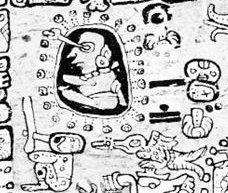1.
Possibly
136 days
(from
January
1 to May
17)
indicates
the
Arabic
manzil
calendar
is
beginning
with the
same
star as
the
Gregorian
calendar,
i.e.
not with
its
heliacal
rising
but with
is
midnight
culmination.
To
observe
a star
rising
in the
east
together
with Sun
will
surely
result
in
blindness:
"The eye is the symbolic site of subjection. Valeri observes that: 'The two sentiments that permit the transcendence of the self are, according to Hawaiians, desire and respect. One and the other are called kau ka maka, literally, 'to set one's eyes on' ... 'To see' (ike) in Hawaiian (as in French or English) is 'to understand', but it is also 'to know sexually'. Witness to the order, the world of forms generated by the chief, the eye, is the sacrifice of those who violate that order. The left eye of the slain tabu-transgressors is swallowed by Kahoali'i, ceremonial double of the king and living god of his sacrificial rites. Like the sun, chiefs of the highest tabus - those who are called 'gods', 'fire', 'heat', and 'raging blazes' - cannot be gazed directly upon without injury. The lowly commoner prostrates before them face to the ground, the position assumed by victims on the platforms of human sacrifice. Such a one is called makawela, 'burnt eyes'." (Marshall Sahlins, Islands of History.)
Instead,
to look
straight
above in
the
midnight
ought to
be the
proper
way for
a star
gazer.
The eye is capable to reach far out to the stars, which no other sense organ can do. The Mayan astronomer in the picture has 24 stars to choose from, as if each one signfied a star at a right ascension hour line. He has picked one out and its image is transferred across cosmic distances directly into his eye (with no harm done).
Earlier
(see at
Cor
Serpentis)
I listed
the
culmination
dates
(according
to
Allen)
for some
prominent
stars:
... The table supports my suggestion that Allen has the wrong date for the culmination of Cor Serpentis. Possibly he took the culmination date for Ras Alhague by mistake. It is possible to perceive a contrast in length between the day differences on one hand for the stars which are rising heliacally early in the 1st half of the year (January - April) and on the other hand for the stars which are rising early in the 2nd half of the year (June - July). Presumably the explanation is that Earth moves quicker in its orbit close to perihelion (in January 4) than close to aphelion (in July 4). This has to be kept in mind when we speculate about the culmination dates for other stars than those listed in my table above ... | ||||||||||||||||||||||||||||||||||||||||||||||||||||||||||||||||||||||||||||||||||||||||||||||||||||||||||||||||||||||||||||||||||||||||||||||||||||||||||||||||||||||||||||||||||||||||||||||||||||||||||||||||||||||
